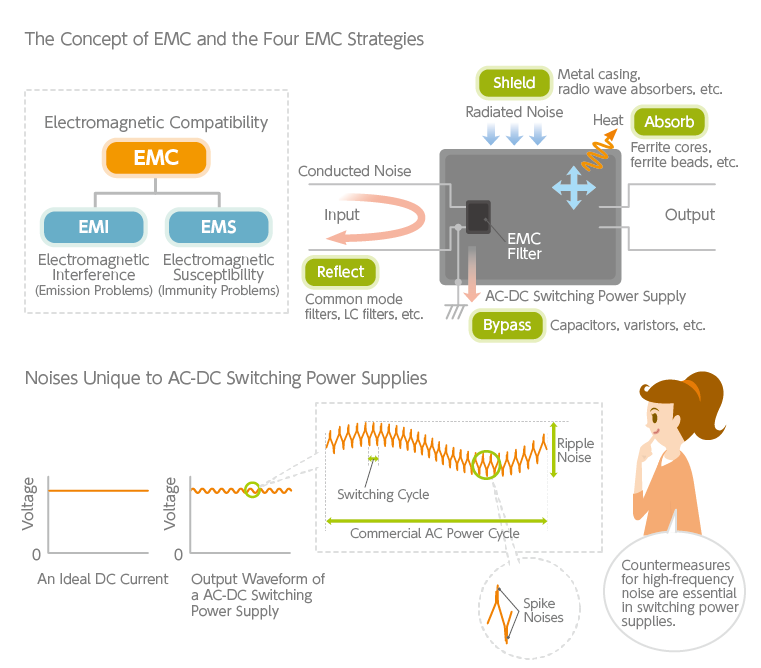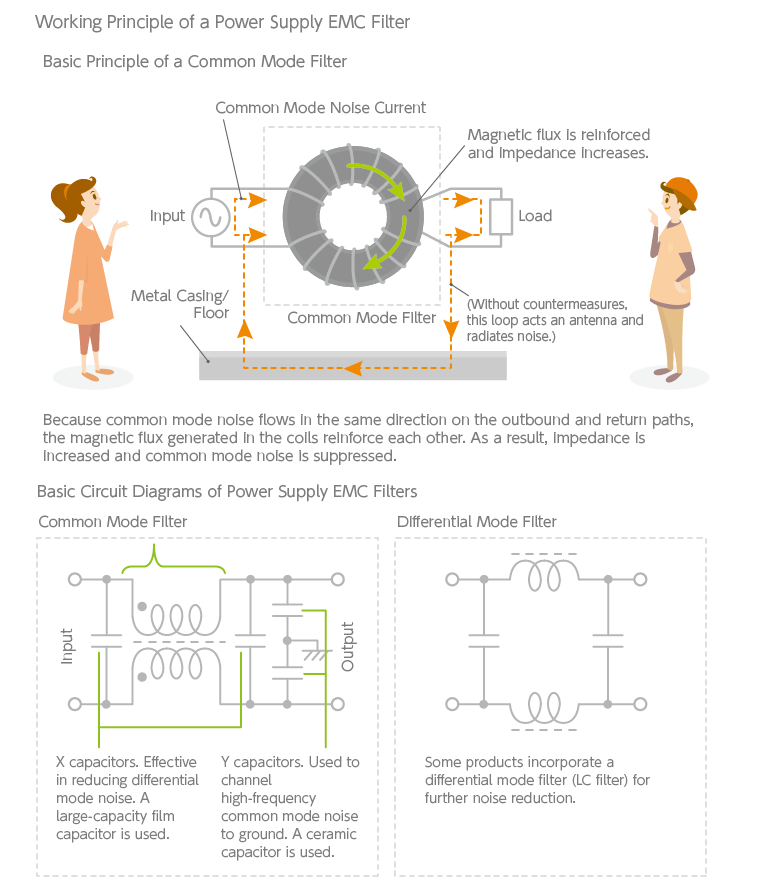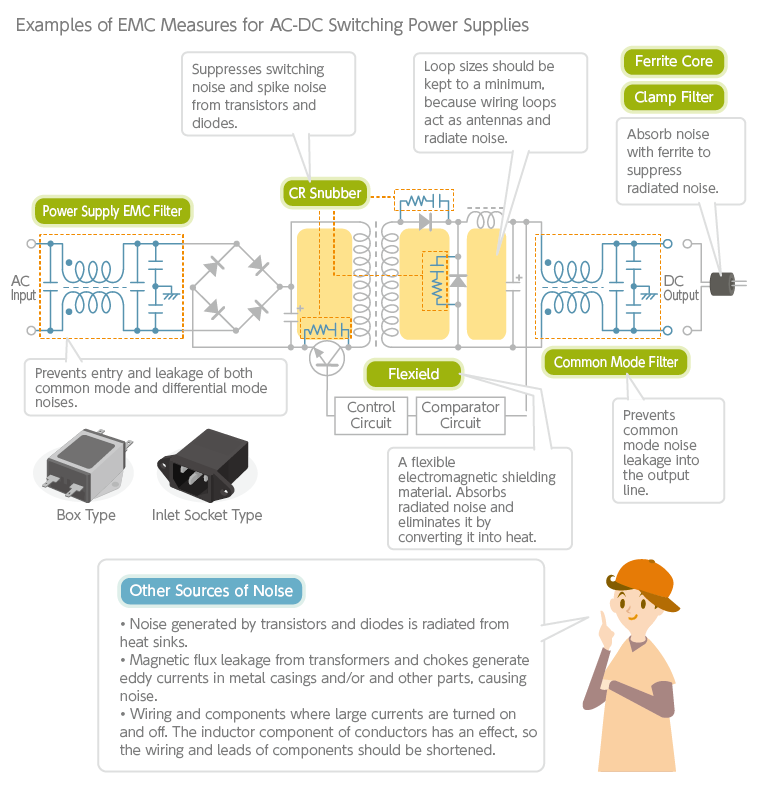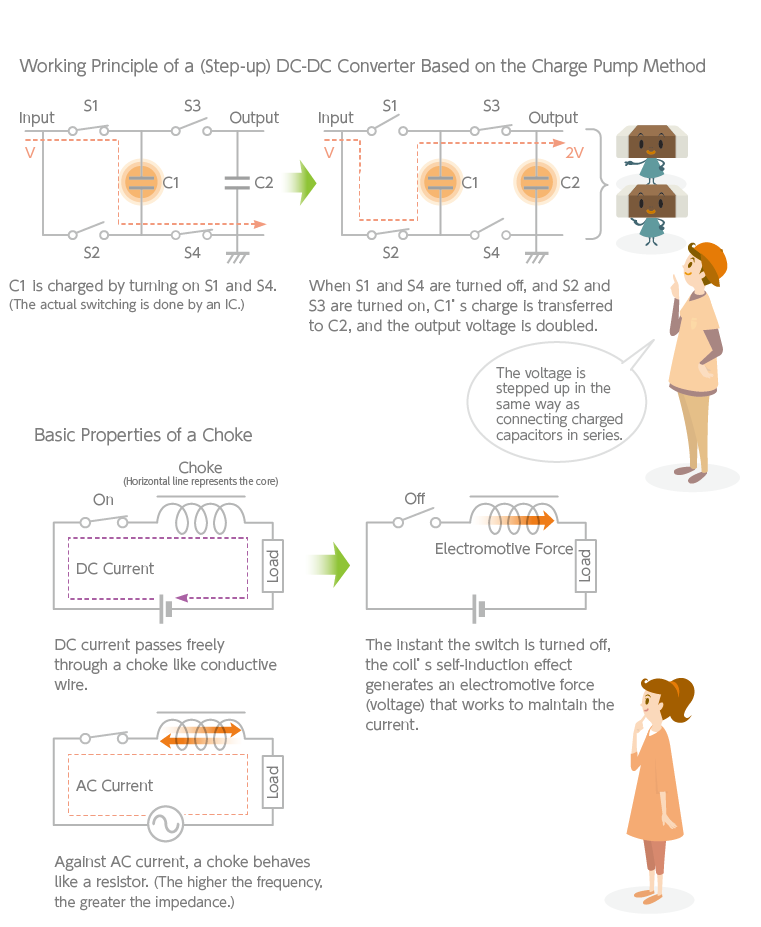The World of Power Electronics
Part 7: Noise Countermeasures for Switching Power Supplies

Switching power supplies have replaced conventional linear power supplies as the mainstream power source for electronic equipment. They have excellent features such as small size, lightweight and high efficiency. However, they also have one weakness unique to switching power supplies: high-frequency noise generated by switching current on and off with semiconductor elements at high speeds. The history of switching power supply technology has been synonymous with a struggle to achieve high efficiency, as well as a battle against noise. A wide variety of noise suppression measures are applied to switching power supplies.
Switching power supplies utilize four EMC strategies: reflection, absorption, bypassing and shielding
Noise countermeasures for electronic equipment are also called EMC measures. Noise problems include EMI (Electromagnetic Interference, or emission problems) and EMS (Electromagnetic Susceptibility, or immunity problems). The idea of addressing both of these is called EMC (Electromagnetic Compatibility). In other words, EMC is about “not causing noise disturbance to other systems (EMI)” and “remaining unaffected by external or self-emitted noise” (EMS).
The switching power supply is an ideal example for learning the basics and application of EMC measures. Switching power supplies are the entry point of external noise from other systems and also the exit point for releasing noise to the load (e.g., IC circuits). The switching power supply itself is also a source of noise. This noise does not only flow through power supply lines as conducted noise but also becomes radiated noise (harmful electromagnetic radiation)—which adversely affects itself and other electronic equipment. It is no overstatement to say that switching power supplies would be useless without EMC measures.
There are four EMC strategies: (1) Reflection—blocking the conduction of noise components with LC filters, (2) Absorption—using ferrite cores and chip beads to absorb noise and convert it into heat, (3) Bypassing—using capacitors and varistors to divert noise to ground, (4) Shielding—removing radiated noise by channeling it to ground through a metal case or absorbing it with a radio wave absorber such as ferrite.
We will use AC-DC switching power supplies as an example to examine the EMC measures found in power electronics equipment. An AC-DC switching power supply is a device that rectifies and smoothes commercial AC power, then converts it into a constant-voltage, stable DC for output using a DC-DC converter. EMC measures are applied to a device’s input, main body, and output.
The first step is the input. Commercial AC is not only a power supply line but also an entry point for various types of conducted noise, such as lightning surges, high-frequency noise from other electrical/electronic equipment, and pulsed noise. To block such noises from entering, an EMC filter (line filter) designed for power supplies is placed at the input. The EMC filter also plays a role in suppressing back noise (feedback noise), which is generated inside the equipment and leaks out.

How common mode chokes function in power supply EMC filters
Conducted noise flowing through power supply lines and signal lines has two types of conduction modes: differential mode and common mode. Differential mode noise is noise transmitted through two conductors, one in the outbound direction and one in return (differential means that the current directions counter each other). Power supply and signal currents are in differential mode, also referred to as normal mode.
Common mode noise, on the other hand, is more complicated. For example, radiated noise generated inside an electronic device can leak out as a weak current through metal casing or the floor and enter other electronic equipment. This type of noise current is called common mode noise. It differs from differential mode noise in that it enters regardless of the outbound/return paths of the power and signal lines and flows in the same direction through two conductors. Characteristically, common mode noise propagates over a wide area, although the voltage levels are low. Because the drive voltages of ICs and LSIs have been decreasing to about 2V to 1V or less in recent years, measures against common mode noise—which can cause IC and LSI malfunctions—are becoming a central part of EMC measures in electronic equipment.
Differential mode noise can be reduced by LC filters which combine an inductor (L) and a capacitor (C), but they are ineffective against common mode noise. For this reason, EMC filters that combine a common mode filter and a capacitor are necessary at the input section of power supply equipment.
A common mode filter consists of a donut-shaped ferrite or amorphous core with two wires wound in the same direction. As common mode noise current flows in the same direction, the magnetic flux inside the core is also generated in the same direction—developing a large impedance and blocking noise from entering. The capacitors at both ends of the common mode filter (called X capacitors) reduce differential mode noise, and capacitors at the output (called Y capacitors) reduce common mode noise by passing it to ground. TDK offers a wide range of power supply EMC filters for different applications, including built-in and inlet socket types.

Total EMC solutions support power supply equipment from inlet to outlet
A variety of EMC measures is applied in the main body of power supply equipment. In TAC-DC switching power supplies, even after rectifying and smoothing the AC current, there are still undulating voltage fluctuations—which can be described as “remnants” of AC. In the DC-DC converter section, where DC voltage is converted, high-frequency switching noise is superimposed on this voltage fluctuation. In addition, a steep noise called spike noise is also generated by the secondary-side commutating diode and superimposed over it. In devices that use direct current from batteries, there is no undulation like there is with AC, but high-frequency switching noise and spike noise are still generated in the DC-DC converter section. To reduce this noise, a CR snubber circuit, consisting of a capacitor (C) and a resistor (R), is placed in parallel with the transistor and commutating diode.
When designing circuit board layouts, components with coils, such as transformers and chokes, must be placed carefully. This is because the leakage of flux from the coil can magnetically couple with other coils and induce noise. Also, when a large current is turned on and off at high speed, the inductor component of the wiring generates noise. Even the leads of electronic components can be a factor, so they must be as short as possible. In this respect, surface-mounted SMD components such as multilayer ceramic chip capacitors are advantageous because they do not have any leads.
When a high-frequency current flows through a looped path, the loop functions like an antenna and radiates noise. Therefore, the loop’s size should be designed to be as small as possible. Compact power supplies are covered entirely with a metal case to shield radiated noise and prevent it from leaking. Because output cables can also act as antennas, ferrite cores and clamp filters are used as radiated noise countermeasures.
An AC-DC switching power supply is like a showcase of EMC measures in which a variety of noise measures are applied. The diagram below shows an overview of them. Even with the same circuit diagram, the performance of switching power supplies varies greatly depending on the wiring pattern and component layout. Power supplies require consistent EMC measures—starting at the inlet, in the main body, and all the way to the outlet. TDK calls this Total EMC Solutions and offers comprehensive services, including noise measurement in an anechoic chamber.

TDK is a comprehensive electronic components manufacturer leading the world in magnetic technology






